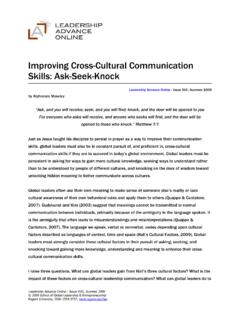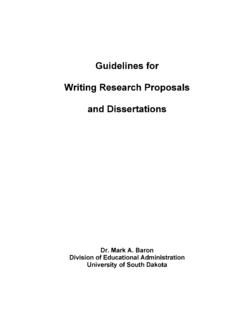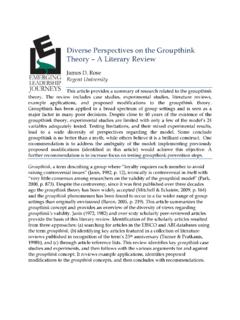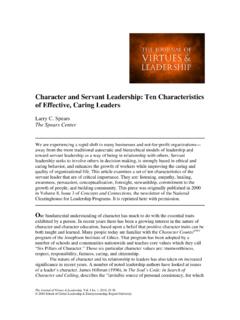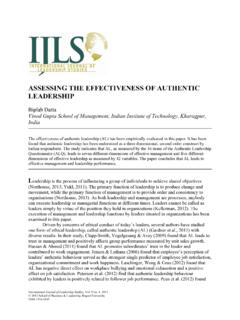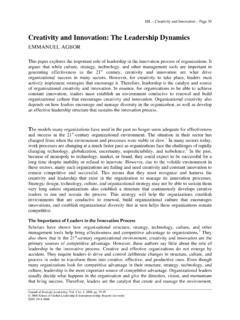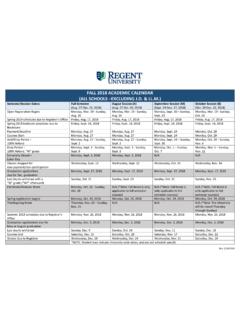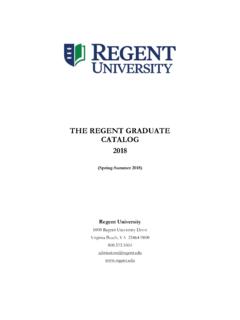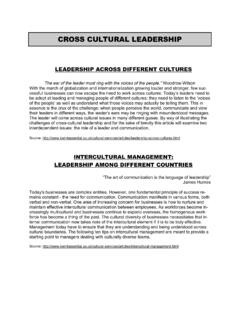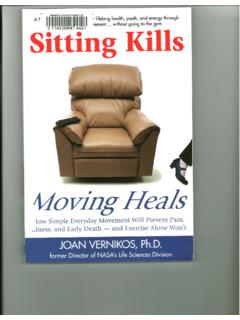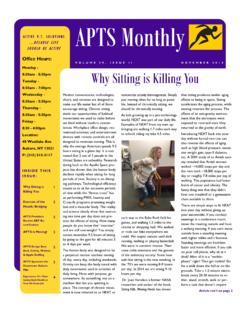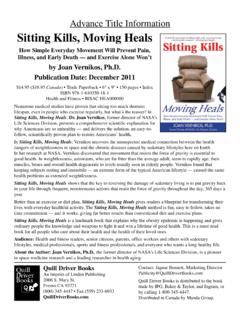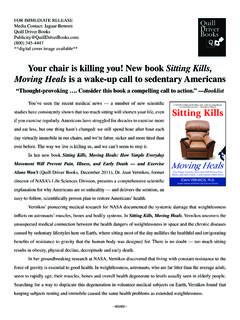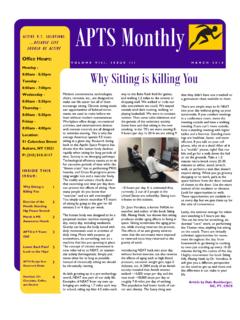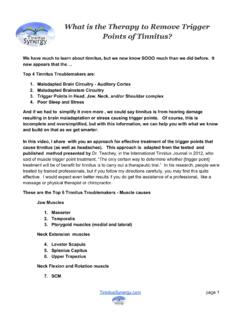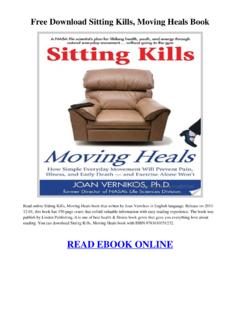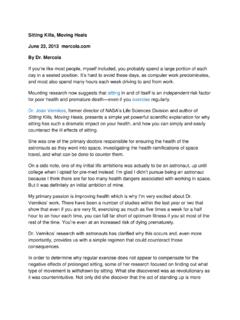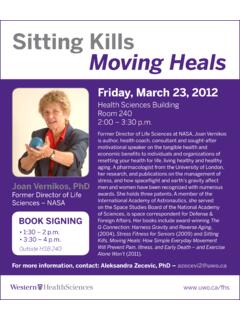Transcription of Diane Chandler: Resource Guides in the area of Christian ...
1 Diane Chandler: Resource Guides in the area of Christian Formation AAAS Grant 3. Christian Formation & Physical Health (Pt. 2): Physical Exercise and Sleep Two other critical dimensions of physical health relate to physical exercise and sleep. Let s look at each dimension. Physical Exercise Another critical dimension related to physical health is physical exercise, and science validates its importance. God created our bodies to move, barring disability or uncontrollable conditions, of course! Taking care of our bodies through physical fitness honors our Creator and enables us to live in the love and flourishing that God intended.
2 Unfortunately, we have become victims of sedentary lifestyles, primarily because of the time we sit in front of screens computer, tablet, mobile phone, television, and cinema. moving more is quickly becoming the prescription for disease avoidance. Joan Vernikos, former director of NASA s Life Sciences Division and NASA scientist for 30 years, purports that the body is not designed to sit for sustained periods of time. Her book sitting Kills, moving Heals, affirms that even standing up frequently can counter the adversarial effects of excessive sitting every 15 minutes or so.
3 Changing positions has numerous health benefits. Prolonged sitting has been attributed to a newly diagnosed phenomenon: sedentary death syndrome, accompanied by high occurrences of heart disease, diabetes, cancers, osteoporosis, and depression. Prevention Magazine notes that being sedentary in America contributes to over 300,000 deaths annually. James A. Levine, co-director of Mayo-Clinic-Arizona State University Obesity Initiative and author of Get Up!: Why Your Chair is Killing You and What You Can Do About It, agrees.
4 As creator of the treadmill desk, Levine asserts that for every hour spent sitting , we lose two hours of our lives. sitting has become the new smoking. What a wake-up call to move more! Physical exercise at any age is beneficial. One study in Norway reported that elderly men who exercised three hours a week outlived their counterparts by five years. Joseph Mercola, physician and host of the #1 natural website in the world, warns that working out in a once-a-day exercise routine will not compensate for the non-movements during our day.
5 Like Vernikos and Levine, Mercola supports moving throughout the day. In his book, Effortless Healing: 9 Simple Ways to Sidestep Illness, Shed Excess Weight, and Help Your Body Fix Itself, Mercola suggests downloading a free timer/alarm on the Internet that will sound in period intervals to remind us to get up, move, stretch, and walk. Stretching and formal exercise, of course, have clear benefits for the muscles, lungs, heart, brain, joints, and bones. In addition to the physical health benefits of exercise, physical activity also stimulates brain functioning.
6 In his book Spark: The Revolutionary New Science of Exercise and the Brain, Harvard psychiatrist John J. Ratey offers a case study of the Naperville, Illinois public school district, which has a rigorous exercise program for its 19,000 students. Research correlates physical exercise with students scoring within the top five globally in math and science. Based on scientific data, Ratey finds an undeniable connection between physical activity and brain functioning. Exercise even benefits sleep cycles. Sleep Sleep is a gift from God in order to renew the body.
7 The Bible demonstrates that peace results in blessed sleep (Ps 4:8; Prov 3:24). Those who fight insomnia know how frustrating it can be to not fall asleep. Imagine -- if a person lives to be 90 years old, he or she will have slept, on average, a total of 30 years. Sleep must be important because in a 24-hour day, we need at least six to eight hours to recharge our batteries. According to the National Institute of Neurological Disorders and Stroke (NINDS), approximately 40 million people in the experience sleep disorders each year, with 20 million experiencing sleep problems.
8 The associated medical costs total $16 billion. How does sleep contribute to health? First, according to physician and writer Don Colbert in his book The Seven Pillars of Health, sleep regulates the body s hormones, such as leptin, which is secreted during sleep and has been found to control appetite. Second, sleep slows the aging process. Third, sleep supports the immune system. Fourth, sleep improves brain function, as mentioned above. Sleep is anything but passive and can be likened to defragging a computer, where all the files better align on a hard drive.
9 Fifth, sleep reduces cortisol levels, the stress hormone associated with diseases. During sleep, tissue repair also occurs. In 2008, CBS aired a two-part series titled The Science of Sleep, hosted by Lesley Stahl. Part 2 was particularly fascinating. Stahl interviewed the top sleep researchers in the , one of whom was endocrinologist Dr. Eve Van Cauter. In the University of Chicago sleep lab, she and her associates discovered that after study participants slept for only four hours for six nights that they developed a pre-diabetic state, typified by escalating blood sugar levels.
10 During sleep deprivation, leptin production decreased, causing them to crave more food. Ongoing scientific research is being done to understand the role of sleep to the body s overall functioning. So how much sleep do we need? The National Sleep Foundation (NSF) suggests the following: (1) most adults 7-9 hours, (2) teenagers 9 hours, (3) school-age children 10-11 hours, (4) toddlers 12-14 hours, and (5) infants 14-15 hours. To encourage a good night s sleep, the NSF also recommends setting a daily time to go to bed, exercise daily for at least 20-30 minutes, refrain from caffeine in the evenings, sleep in a darkened room with a cool temperature, and relax before bed.
